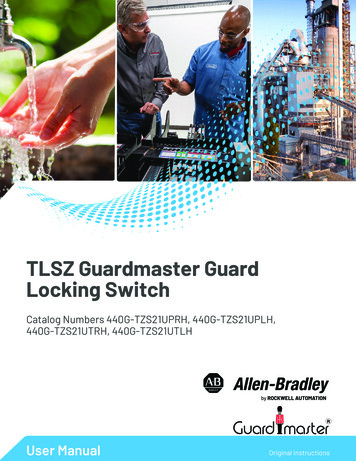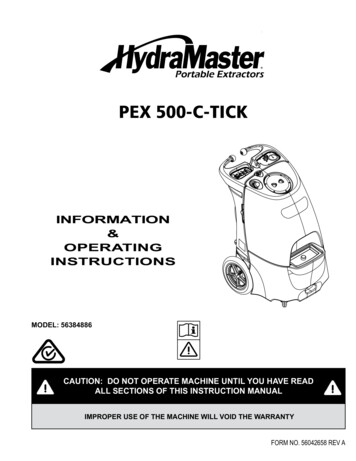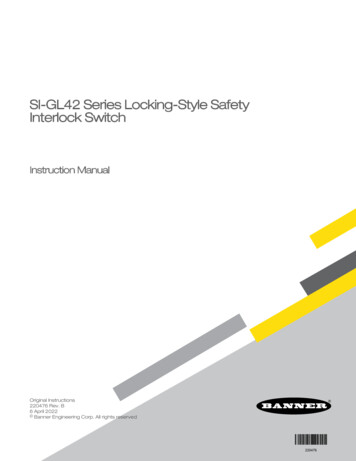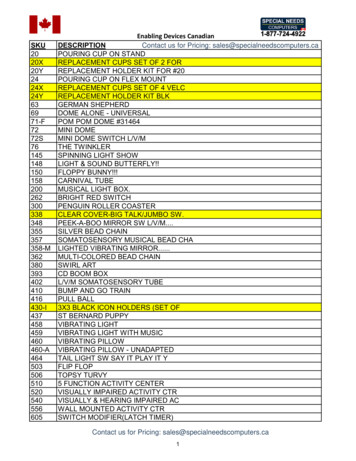
Transcription
TLSZ Guardmaster GuardLocking SwitchCatalog Numbers 440G-TZS21UPRH, 440G-TZS21UPLH,440G-TZS21UTRH, 440G-TZS21UTLHUser ManualOriginal Instructions
TLSZ Guardmaster Guard Locking Switch User ManualImportant User InformationRead this document and the documents listed in the additional resources section about installation, configuration, andoperation of this equipment before you install, configure, operate, or maintain this product. Users are required to familiarizethemselves with installation and wiring instructions in addition to requirements of all applicable codes, laws, and standards.Activities including installation, adjustments, putting into service, use, assembly, disassembly, and maintenance are required tobe carried out by suitably trained personnel in accordance with applicable code of practice.If this equipment is used in a manner not specified by the manufacturer, the protection provided by the equipment may beimpaired.In no event will Rockwell Automation, Inc. be responsible or liable for indirect or consequential damages resulting from the useor application of this equipment.The examples and diagrams in this manual are included solely for illustrative purposes. Because of the many variables andrequirements associated with any particular installation, Rockwell Automation, Inc. cannot assume responsibility or liability foractual use based on the examples and diagrams.No patent liability is assumed by Rockwell Automation, Inc. with respect to use of information, circuits, equipment, or softwaredescribed in this manual.Reproduction of the contents of this manual, in whole or in part, without written permission of Rockwell Automation, Inc., isprohibited.Throughout this manual, when necessary, we use notes to make you aware of safety considerations.WARNING: Identifies information about practices or circumstances that can cause an explosion in a hazardous environment,which may lead to personal injury or death, property damage, or economic loss.ATTENTION: Identifies information about practices or circumstances that can lead to personal injury or death, propertydamage, or economic loss. Attentions help you identify a hazard, avoid a hazard, and recognize the consequence.IMPORTANTIdentifies information that is critical for successful application and understanding of the product.These labels may also be on or inside the equipment to provide specific precautions.SHOCK HAZARD: Labels may be on or inside the equipment, for example, a drive or motor, to alert people that dangerousvoltage may be present.BURN HAZARD: Labels may be on or inside the equipment, for example, a drive or motor, to alert people that surfaces mayreach dangerous temperatures.ARC FLASH HAZARD: Labels may be on or inside the equipment, for example, a motor control center, to alert people topotential Arc Flash. Arc Flash will cause severe injury or death. Wear proper Personal Protective Equipment (PPE). Follow ALLRegulatory requirements for safe work practices and for Personal Protective Equipment (PPE).The following icon may appear in the text of this document.Identifies information that is useful and can help to make a process easier to do or easier to understand.2Rockwell Automation Publication 440G-UM002C-EN-P - June 2022
Table of ContentsAbout This Publication . . . . . . . . . . . . . . . . . . . . . . . . . . . . . . . . . . . . . . . . . . .Who Should Use This Manual . . . . . . . . . . . . . . . . . . . . . . . . . . . . . . . . . . . . .Summary of Changes. . . . . . . . . . . . . . . . . . . . . . . . . . . . . . . . . . . . . . . . . . . . .Additional Resources . . . . . . . . . . . . . . . . . . . . . . . . . . . . . . . . . . . . . . . . . . . . .Terminology. . . . . . . . . . . . . . . . . . . . . . . . . . . . . . . . . . . . . . . . . . . . . . . . . . . . .55556Chapter 1General DescriptionGuardmaster TLSZ Guard Locking Switch Overview. . . . . . . . . . . . . . . . . 7Catalog Number Explanation . . . . . . . . . . . . . . . . . . . . . . . . . . . . . . . . . . . . . 7Packaging Contents . . . . . . . . . . . . . . . . . . . . . . . . . . . . . . . . . . . . . . . . . . . . . . 8Chapter 2InstallationGeneral Considerations. . . . . . . . . . . . . . . . . . . . . . . . . . . . . . . . . . . . . . . . . . . 9Actuator/Target Mounting . . . . . . . . . . . . . . . . . . . . . . . . . . . . . . . . . . . . . . . . 9Allowable Approach Directions . . . . . . . . . . . . . . . . . . . . . . . . . . . . . . . . . . . . 9Minimum Operating Radius . . . . . . . . . . . . . . . . . . . . . . . . . . . . . . . . . . . . . 10Manual Release . . . . . . . . . . . . . . . . . . . . . . . . . . . . . . . . . . . . . . . . . . . . . . . . . 10Manual Override Cover . . . . . . . . . . . . . . . . . . . . . . . . . . . . . . . . . . . . . . . . . . 11Pair Proximity . . . . . . . . . . . . . . . . . . . . . . . . . . . . . . . . . . . . . . . . . . . . . . . . . . 11Guide Repositioning . . . . . . . . . . . . . . . . . . . . . . . . . . . . . . . . . . . . . . . . . . . . 11Steel Locking Bolts . . . . . . . . . . . . . . . . . . . . . . . . . . . . . . . . . . . . . . . . . . . . . . 12Actuator Clearance . . . . . . . . . . . . . . . . . . . . . . . . . . . . . . . . . . . . . . . . . . . . . . 12Approximate Dimensions. . . . . . . . . . . . . . . . . . . . . . . . . . . . . . . . . . . . . . . . 13Chapter 3WiringConnections . . . . . . . . . . . . . . . . . . . . . . . . . . . . . . . . . . . . . . . . . . . . . . . . . . . .OSSD Inputs . . . . . . . . . . . . . . . . . . . . . . . . . . . . . . . . . . . . . . . . . . . . . . . . . . .OSSD Outputs . . . . . . . . . . . . . . . . . . . . . . . . . . . . . . . . . . . . . . . . . . . . . . . . . .Auxiliary Output . . . . . . . . . . . . . . . . . . . . . . . . . . . . . . . . . . . . . . . . . . . . . . . .Lock Command . . . . . . . . . . . . . . . . . . . . . . . . . . . . . . . . . . . . . . . . . . . . . . . . .1515151616Chapter 4CommissioningPreparation . . . . . . . . . . . . . . . . . . . . . . . . . . . . . . . . . . . . . . . . . . . . . . . . . . . .First Time Power-up . . . . . . . . . . . . . . . . . . . . . . . . . . . . . . . . . . . . . . . . . . . .Learn First Target . . . . . . . . . . . . . . . . . . . . . . . . . . . . . . . . . . . . . . . . . . . . . . .Learn Additional Targets . . . . . . . . . . . . . . . . . . . . . . . . . . . . . . . . . . . . . . . .Commissioning Errors . . . . . . . . . . . . . . . . . . . . . . . . . . . . . . . . . . . . . . . . . .Power-up Self-check. . . . . . . . . . . . . . . . . . . . . . . . . . . . . . . . . . . . . . . . . . . . .171818181919Chapter 5Functional TestingTesting Procedure. . . . . . . . . . . . . . . . . . . . . . . . . . . . . . . . . . . . . . . . . . . . . . . 21Chapter 6Application and WiringExamplesWiring to GLP Relay. . . . . . . . . . . . . . . . . . . . . . . . . . . . . . . . . . . . . . . . . . . . . 23Circuit Status as Shown . . . . . . . . . . . . . . . . . . . . . . . . . . . . . . . . . . . . . . 24Rockwell Automation Publication 440G-UM002C-EN-P - June 20223
Wiring to GLT Relay. . . . . . . . . . . . . . . . . . . . . . . . . . . . . . . . . . . . . . . . . . . . .Circuit Status as Shown . . . . . . . . . . . . . . . . . . . . . . . . . . . . . . . . . . . . . .Wiring to DI and EMD Relay . . . . . . . . . . . . . . . . . . . . . . . . . . . . . . . . . . . . .Circuit Status as Shown . . . . . . . . . . . . . . . . . . . . . . . . . . . . . . . . . . . . . .Wiring to DG Relay . . . . . . . . . . . . . . . . . . . . . . . . . . . . . . . . . . . . . . . . . . . . .Wiring to CR30 Software Configurable Safety Relay . . . . . . . . . . . . . . . .Wiring to 1734 POINT Guard I/O . . . . . . . . . . . . . . . . . . . . . . . . . . . . . . . . .Wiring to 1732 ArmorBlock. . . . . . . . . . . . . . . . . . . . . . . . . . . . . . . . . . . . . . .2425262727283135Chapter 7Diagnostics andTroubleshootingTools Needed . . . . . . . . . . . . . . . . . . . . . . . . . . . . . . . . . . . . . . . . . . . . . . . . . . . 39Required Tools . . . . . . . . . . . . . . . . . . . . . . . . . . . . . . . . . . . . . . . . . . . . . . 39Optional Tools. . . . . . . . . . . . . . . . . . . . . . . . . . . . . . . . . . . . . . . . . . . . . . . 39Flowchart . . . . . . . . . . . . . . . . . . . . . . . . . . . . . . . . . . . . . . . . . . . . . . . . . . . . . . 40Step 1 — StatusIndicator Off . . . . . . . . . . . . . . . . . . . . . . . . . . . . . . . . . . . . . . . . . . . . . . . . . . . 40Step 2 — Status Indicator Flashing Red at 4 Hz . . . . . . . . . . . . . . . . . . . . 41Wrong Target . . . . . . . . . . . . . . . . . . . . . . . . . . . . . . . . . . . . . . . . . . . . . . . 41Missing Target . . . . . . . . . . . . . . . . . . . . . . . . . . . . . . . . . . . . . . . . . . . . . . 41Target Not Mounted Correctly . . . . . . . . . . . . . . . . . . . . . . . . . . . . . . . . 42Pair Proximity. . . . . . . . . . . . . . . . . . . . . . . . . . . . . . . . . . . . . . . . . . . . . . . 42Mechanical Pressure on Safety Gate . . . . . . . . . . . . . . . . . . . . . . . . . . . 42Long Wiring . . . . . . . . . . . . . . . . . . . . . . . . . . . . . . . . . . . . . . . . . . . . . . . . 43Voltage Supply Dips . . . . . . . . . . . . . . . . . . . . . . . . . . . . . . . . . . . . . . . . . 44Rapid Locking . . . . . . . . . . . . . . . . . . . . . . . . . . . . . . . . . . . . . . . . . . . . . . . 44Step 3 - Status Indicator Flashes Red at 1 Hz . . . . . . . . . . . . . . . . . . . . . . . 45Capacitive Loading . . . . . . . . . . . . . . . . . . . . . . . . . . . . . . . . . . . . . . . . . . 45Step 4 — Status Indicator Flashes Green at 1 Hz. . . . . . . . . . . . . . . . . . . . 46Corrective Action: . . . . . . . . . . . . . . . . . . . . . . . . . . . . . . . . . . . . . . . . . . . 46Step 5 — Flashing Red and Green . . . . . . . . . . . . . . . . . . . . . . . . . . . . . . . . . 46Step 6 — Indicator Steady Red . . . . . . . . . . . . . . . . . . . . . . . . . . . . . . . . . . . 46Step 7 — Other Considerations . . . . . . . . . . . . . . . . . . . . . . . . . . . . . . . . . . . 46Distribution Block . . . . . . . . . . . . . . . . . . . . . . . . . . . . . . . . . . . . . . . . . . . 46GSR Relays on Power-up . . . . . . . . . . . . . . . . . . . . . . . . . . . . . . . . . . . . . 48Appendix ASpecificationsSafety Ratings . . . . . . . . . . . . . . . . . . . . . . . . . . . . . . . . . . . . . . . . . . . . . . . . . .Operating Characteristics. . . . . . . . . . . . . . . . . . . . . . . . . . . . . . . . . . . . . . . .Environmental . . . . . . . . . . . . . . . . . . . . . . . . . . . . . . . . . . . . . . . . . . . . . . . . .General . . . . . . . . . . . . . . . . . . . . . . . . . . . . . . . . . . . . . . . . . . . . . . . . . . . . . . . .Declaration of Conformity . . . . . . . . . . . . . . . . . . . . . . . . . . . . . . . . . . . . . . .CE Conformity . . . . . . . . . . . . . . . . . . . . . . . . . . . . . . . . . . . . . . . . . . . . . .UKCA Conformity . . . . . . . . . . . . . . . . . . . . . . . . . . . . . . . . . . . . . . . . . . .49495050505050Index . . . . . . . . . . . . . . . . . . . . . . . . . . . . . . . . . . . . . . . . . . . . . . . . . . . . . . . . 514Rockwell Automation Publication 440G-UM002C-EN-P - June 2022
PrefaceAbout This PublicationThis manual is a reference guide for the Guardmaster TLSZ guard lockingswitch. This manual: Explains how to install and wire your TLSZ guard locking switch. Provides an overview of the Guardmaster TLSZ guard locking switch.Who Should Use ThisManualUse this manual to design, install, program, or troubleshoot systems that usethe TLSZ Guardmaster guard locking safety switches.You are required to have a basic understanding of electrical circuitry andfamiliarity with safety-related control systems. If you do not, obtain the propertraining before using this product.Summary of ChangesThis publication contains the following new or updated information. This listincludes substantive updates only and is not intended to reflect all changes.TopicUpdated Terminology table.Updated Catalog Number Explanation section.Added UKCA certification to Safety Ratings table.Added Declaration of Conformity section.Additional ResourcesPage674950These documents contain additional information concerning related productsfrom Rockwell Automation.ResourceGuardmaster Configurable Safety Relay WiringDiagrams, publication 440C-WD001Industrial Automation Wiring and GroundingGuidelines, publication 1770-4.1Functional Safety Data Sheet,publication SAFETY-SR001Industrial Automation Glossary, publication AG-7.1Product Certifications s example wiring diagrams for the CR30 softwareconfiguration safety relay.Provides general guidelines for installing aRockwell Automation industrial system.Provides functional safety data and details forRockwell Automation products.Glossary of industrial automation terms and abbreviationsProvides declarations of conformity, certificates, and othercertification details.You can view or download publications at rok.auto/literature.Rockwell Automation Publication 440G-UM002C-EN-P - June 20225
TerminologyThe Industrial Automation Glossary contains terms and abbreviations that areused by Rockwell Automation to describe industrial automation systems.Table 1 lists specific terms and abbreviations that are used in this manual.Table 1 - TerminologyTermNCN.C. (Normally Closed)N.O. (Normally Open)PLCPTL (Power to Lock)PTR (Power to Release)Reaction TimeResponse TimeRFIDOSSD (Output SignalSwitching Device)Standard codingTLSZLTLSZRUnique coding6DescriptionNo connectionAn electrical contact whose normal state (for example, no pressure or electricalpotential applied) is in the closed position.An electrical contact whose normal state (such as no pressure or electrical potentialapplied) is in the open position.A programmable logic controller or a programmable automation controller.Apply 24V to the lock command to lock the switch. This command applies to theTLSZL guard locking switch.Apply 24V to the lock command to unlock the switch. This command applies to theTLSZR guard locking switch.Describes the time between the true state of the input to the on state of the output.Describes the time between the trigger of the input to the off state of the output.Throughout this manual, the safety outputs are described as turning off immediately(turning off within the response time).Radio frequency identification.Typically a pair of solid-state signals pulled up to the DC source supply. The signalsare tested for short circuits to the DC power supply, short circuits to the DC common,and short circuits between the two signals.Same as low coding as defined in EN ISO 14119:2013TLSZ Power to Lock guard locking switchTLSZ Power to Release guard locking switchSame as high coding as defined in EN ISO 14119:2013Rockwell Automation Publication 440G-UM002C-EN-P - June 2022
Chapter1General DescriptionGuardmaster TLSZ GuardLocking Switch OverviewThis Guardmaster TLSZ guard locking switch functions by locking itactuator, which prohibits the opening of a guard.The TLSZ guard locking switch uses radio frequency identification, RFID,coding to detect the appropriate target.This version of the Guardmaster TLSZ guard locking switch features OSSDoutputs. These outputs are enabled only when the actuator is locked and the RFtarget is sensed.This device is intended to be part of the safety-related control system of amachine. Perform a risk assessment before installation to determine whetherthe specifications of this device are suitable for all operational andenvironmental characteristics of the machine. See Specifications on page 49for certification information and ratings.Use nonremovable screws, bolts, or nuts to mount the switch and actuators.Do not over torque the mounting hardware.TLSZ guard locking switches are classified according to ISO 14119 as Type 4switching devices. The RFID targets are classified as having a high level ofcoding.Take measures to minimize the need to defeat and to manage the use andavailability of spare RFID targets.Catalog NumberExplanation440aCode440CodeZCodePTG bTcZdS21eUfbDescriptionGuard locking switchPgRhHiaDescriptionSafeguards the productCodeGdLock TypeDescriptionPLe rated, cascadablesafety signalseConnection TypeCodeDescriptionSolid-stateoutputs, 2S21safety (OSSD), 1 auxfSpecial FeaturesCodeDescriptiongLock TypeDescriptionAux signal shows lockstatusAux signal shows doorstatushConnection TypeCodeDescriptioniSpecial FeaturesCodeDescriptionRPower to ReleaseLPower to LockRockwell Automation Publication 440G-UM002C-EN-P - June 2022CodeTUHcDescriptionTitan locking switchUnique coded RFID target8-pin M12 QD connector7
Chapter 1General DescriptionATTENTION: Guard locking switches that use the Power to Lock principle canonly be used after a risk assessment shows that the Power to Releaseprinciple is inappropriate for the application. If a power supply loss occurswith Power to Lock switches, the switches immediately unlock and you canaccess the hazards.Packaging ContentsFigure 1 shows the contents in the shipping package. The contents include: Switch Actuator RFID target T20 security Torx bit Two steel bolts and nuts Plug Installation instructions (not shown)Figure 1 - Package Contents8Rockwell Automation Publication 440G-UM002C-EN-P - June 2022
Chapter2InstallationGeneral ConsiderationsThe TLSZ guard locking switch is designed for use on guards that areengineered to be rigid and without sag. The TLSZ guard locking switch usesradio frequency identification (RFID) coding to detect the appropriate target.Actuator/Target MountingFigure 2 shows the correct and incorrect ways to mount the target with theactuator.The TLSZ guard locking switch must only be used with the fully flexibleactuator. The replacement part number for the actuator is catalog number440G-A27143.Figure 2 - Target/Actuator MountingTargetActuator Allowable ApproachDirections The actuator and target must be always mounted as “close coupled” and canapproach the switch in any of the three entry slot positions that are shown inFigure 3. Approach from the underside is not allowed, as the distance from thetarget to the internal RF sensor is too far for proper operation.Figure 3 - Allowable Approach DirectionThis approach requiresguide repositioning, seepage 11.Rockwell Automation Publication 440G-UM002C-EN-P - June 20229
Chapter 2InstallationMinimum Operating RadiusFigure 4 shows the minimum operating distances along the length andperpendicular when applied to hinged doors.Figure 4 - Minimum Operating Distance [mm (in.)]80 (3.19)80 (3.19)80 (3.19)80 (3.19)Figure 5 shows the location of the two 1.5 mm (0.06 in.) set screws that can beadjusted to preset the actuator to an optimal angle, if needed.Figure 5 - Actuator Set Screw1.5 mm (0.06 in.)Manual ReleaseThe manual release feature only applies to TLSZR (Power to Release) switch. Insome cases, you must manually release the locked actuator.Figure 6 shows the two locations from which the actuator can be manuallyreleased.1. Remove the T20 Torx screw.2. To release the actuator, insert a small screwdriver or rod in the hole.If power is applied to the switch when the actuator is released, the OSSD safetyoutputs turn off and the switch goes to a faulted state with the status indicatorflashing red at 4 Hz. Power then must be cycled to the switch to return it to anoperational state.Figure 6 - Manual Release31T2022 2.5 (0.10) Ø10Rockwell Automation Publication 440G-UM002C-EN-P - June 2022
Chapter 2Manual Override CoverInstallationFigure 7 shows an optional cover that is available only for the TLSZR (Power toRelease) switch. This cover has a lever that allows you to unlock the actuatormanually at any time. Rotate the lever 90 to unlock the actuator.If power is applied to the switch when the actuator is released, the OSSD safetyoutputs turn off, and the switch goes to a faulted state with the status indicatorflashing red at 4 Hz. Power is then cycled to the switch to return it to anoperational state.Figure 7 - Manual Override Cover121.2 N m (10.62 lb in)90 90 Pair ProximityIf a pair of TLSZ guard locking switches are mounted too close to each other,the two RF fields could interact causing crosstalk. Cross talk results innuisance faults.A minimum of 200 mm (8 in.) must be used to help achieve correct operation.The restriction also applies if a TLSZ guard locking switch is mounted close tothe 440G-LZ guard locking and the 440N-Z SensaGuard switches.Guide RepositioningThe actuator guide can be repositioned to facilitate alignment of the actuator.In steps 8 11 (Figure 8), rotate the metal guide to allow the switch body to befastened flush to the mounting surface.Figure 8 - Guide Repositioning27315648180 10119Rockwell Automation Publication 440G-UM002C-EN-P - June 202211
Chapter 2InstallationSteel Locking BoltsThe TLSZ guard locking switch is assembled in the factory with plastic pinsthat secure the actuator guide. The plastic pins are rated for a holding force of1500 N (337 lb). The plastic pins must be replaced with the steel bolts to achievea holding force of 2000 N (585 lb). Figure 9 shows how to remove the cover toreplace the blue plastic pins with steel bolts.Figure 9 - Steel Bolt Installation1.2 N m (10.62 lb in.)5 (0.20)dia.15 (0.59)2 x M51.4 N m(12.39 lb in.)1.2 N m (10.62 lb in.)2 x M51.4 N m (12.39 lb in.)Plastic pinsFzh 1500 N (337 lb)Actuator ClearanceSteel boltsFzh 2000 N (450 lb)Figure 10 shows the clearance requirements for the TLSZ guard locking switch.The switch must not be used as a guard stop. You must provide a mechanicalstop at least 1 mm (0.04 in.) away from the actuator guide. The actuator mustbe inserted within 4 mm (0.16 in.) or less from the actuator guide to be sure itlocks.Figure 10 - Clearance and Insertion Distance1 41 4(0.04 0.16)(0.04 0.16)As shown in Figure 11 on page 13, the TLSZ guard locking switch has twoslotted holes to facilitate installation. The slots allow up to 8 mm (0.31 in.) ofmovement of the switch body to achieve the proper clearance with theactuator.1. Use the slotted holes for initial installation.2. After alignment with the actuator, secure the switch body in place byadding mounting hardware in the circular holes.12Rockwell Automation Publication 440G-UM002C-EN-P - June 2022
Chapter 2Installation3. To attain the maximum holding force, replace the plastic pins with steelscrews inside the cover.Figure 11 - Mounting Slots for Alignment [mm (in.)]M5 213Status/Diagnostic8 (0.31)Figure 12 shows the approximate dimensions for the switch, target, andactuator.6.5 (0.26)9 (0.35)5 (0.2)3 (0.12)440G-ATZAE-xxxx29.3 (1.15)M521 (0.83)73 (2.87)Static/M5 x 4DiagnosticLED6.5 (0.26)19(0.75)86 (3.39)57 (2.24)Target alignment mark23.2 (0.91)11.9(0.47)6.5 (0.26)17(0.67)6 (0.24)126 (4.96)105 (4.13)27 (1.06)39 (1.54)22 (0.87)33 (1.3)14 (0.55)3 (0.12)21(0.83)17 (0.67)43 (1.69)20.5 (0.81)25.5 (1)5 (0.2)5 (0.2)14 (0.55)Figure 12 - Approximate Dimensions [mm (in.)]5.5 (0.22)Approximate Dimensions31.5 (1.24)52.5 (2.07)60.5 (2.38)67.5 (2.66)14.5(0.57)4 0.71)2 x M3Do not use cable gland knockouts, two places19(0.75)13(0.51)51(2.0)24(0.94)4 x 5.5 (0.22)20(0.79)31 (4.22)840 (1.57) (0.31)52 (2.05)ActuatorUse with flexible actuator only6.8(0.27)2.2 (0.09)4.2 (0.17)19.2 (0.76)Rockwell Automation Publication 440G-UM002C-EN-P - June 2022Connector location anddimensions13
Chapter 2InstallationFigure 13 shows the dimensions for mounting the target that is next to theactuator.Figure 13 - Actuator/Target Mounting Dimensions [mm (in.)]7 (0.28)35(1.38)5.5 (0.22)86.5(3.4)40(1.57)6 (0.24)6 (0.24)20(0.79)13 (0.51)19(0.75)3 x M5TargetActuator14Rockwell Automation Publication 440G-UM002C-EN-P - June 2022
Chapter3WiringConnectionsThe TLSZ guard locking switch is only available with an 8-pin DC Micro M12quick-disconnect connector. Figure 14 and Table 2 show the pin assignmentsand their functions and typical mating cordsets. Other cordsets are available ds.html.Figure 14 - 8-pin Micro Quick Disconnect Cables3 Lock Command2 24V DC 8 Safety A Input1 Aux7 0V4 Safety B Input5 Safety A Output6 Safety B OutputTable 2 - TLSZ Quick Disconnect Pin AssignmentsTypical Mating Cordsets889D-F8NB-x (1)(Red, PVC)889D-F8AB-x (1)(Black, inkBlueRed24V DC SupplyLock CommandSafety B InputSafety A Output (OSSD A)Safety B Output (OSSD B)Ground (0V)Safety A Input2345678(1) Replace symbol with 2 [2 m (6.56 ft)], 5 [5 m (16.4 ft)], 10 [10 m (32.8 ft)], 15 [15 m (49.2 ft)] 20 [20 m [65.62 ft)] or 30 [30 m(98.4 ft)] for standard cable lengths. The TLSZ guard locking switch is tested to operate with up to 120 m (393.7 ft) of themating cables.OSSD InputsThe OSSD inputs are Safety A and Safety B . These inputs can be pure24V DC, or they can contain test pulses. The OSSD inputs allow the TLSZ guardlocking switches to be connected in-series while maintaining a high level ofsafety performance.OSSD OutputsThe OSSD outputs are Safety A and Safety B. These outputs are 24V signalsthat contain test pulses. The test pulses are used to detect short circuits to 24V,to 0V and cross faults (from Safety A to Safety B). This description of the testpulses is provided for informational purposes; you cannot modify them.Figure 15 on page 16 shows the safety output test pulses when connected to a 1Kresistive load for hardware (HW) revisions A and B, and for firmware (FW)revisions A through C. The pulses are 25 μs wide and repeat every 20 ms. Theexact shape of the pulses depends on the nature of the load. The capacitive andresistive effects of the load are determined with the combination of cabling,cable routing, and connected devices.Rockwell Automation Publication 440G-UM002C-EN-P - June 202215
Chapter 3WiringFigure 15 - Output Test PulsesSafety B (Pink)Safety A (Gray)5V/Div25µs/DivAuxiliary OutputTable 3 shows the auxiliary output functions. The auxiliary output is a 24V DClogic signal, whose function is dependent on the catalog number selected. Theauxiliary signal responds independently of the OSSD safety outputs. Theauxiliary output is not a safety-rated signal and must only be used to indicatethe status of the switch.Table 3 - Auxiliary Output FunctionCat. TZS21UTLHLock CommandFunctionLock StatusActuator StatusValue24V when actuator is unlocked0V when actuator is locked24V when actuator inserted (gate closed)0V when actuator removed (gate open)Table 4 shows the lock command function. The lock command is a 24V logicsignal, with a current of less than 5 mA. The function of the logic signal isdependent on the catalog number. The 24V power supply connection providesthe power to operate the locking solenoid.Table 4 - Lock Command FunctionCat. TZS21UTLH16Switch TypePower to ReleasePower to LockFunction24V unlocks the actuator0V locks the actuator24V locks the actuator0V unlocks the actuatorRockwell Automation Publication 440G-UM002C-EN-P - June 2022
Chapter4CommissioningBefore use, the guard locking switch must first learn a new RFID target. Thisstep is not done at the factory.The guard locking switch can learn up to eight targets consecutively. Use thisprocess if there is a potential for the target to become damaged, inoperable, orlost. When a new target is learned, the guard locking switch no longerrecognizes the old target.PreparationWire the guard locking switch with at minimum the functionality shown inFigure 16. Power — connect the brown wire to 24V. Gnd — connect the blue wire to 0V. Lock — Leave the green wire open when learning the first target.Connect the green wire to 24V to teach a TLSZR guard locking switchsubsequent targets. The TLSZL guard locking switch ignores the Lockcommand during learning. Safety A and Safety B — connect red and yellow wires to 24V duringcommissioning. If 24V is not applied to the A and B inputs, then theindicator flashes green after commissioning if the guard locking switchis locked. Safety A and Safety B — optional, no connection required forcommissioning. Aux — optional, no connection required for commissioning.Figure 16 - Commissioning Wiring 24V DCTLSZ-GD2Status Diag889D-F8NB-xor889D-F8AB-xBrown ( 24)Red (OSSD A )Yellow (OSSD B )Green (Lock)Gray (OSSD A)Pink (OSSD B)White (Aux)Blue (Gnd)Rockwell Automation Publication 440G-UM002C-EN-P - June 2022LockNCNCNC24V DC Com17
Chapter 4CommissioningFirst Time Power-upTurn on the 24V DC power without the actuator and target.The Status/Diagnostic indicator blinks green three times, pauses 2 seconds,and then blinks green eight times. Eight is the number of times a new targetcan be learned. The guard locking switch continuously repeats the two-secondpause followed by the eight blink sequence.Learn First TargetTable 5 shows the events that take place when the first target is learned. Thelock command is ignored until after the guard locking switch learns its firsttarget, therefore, the lock command can be 24V or 0V during the first-timelearning sequence.Table 5 - First Target Learning EventsStep123456789Learn Additional TargetsEventApply power to guard locking switchPresent actuator/targetDetect targetVerifying targetReport commissioning error (seeTable 7 on page 19) or continueProgramming switchFinalizingNumber of learns remainingLearn completedPTRPTLIndicator ColorRedRedRedGreen/RedBlink RateSolidSolidSolid1 HzDuration——2 25 s15 s———Green/RedRedGreen4 HzSolid# of learns15 s2s15 sGreenRedSolidContinuousTable 6 shows the steps that take place when teaching the guard locking switchto recognize an
T20 security Torx bit Two steel bolts and nuts Plug Installation instructions (not shown) Figure 1 - Package Contents ATTENTION: Guard locking switches that use the Power to Lock principle can only be used after a risk assessment shows that the Power to Release principle is inappropriate for the application. If a power supply .










